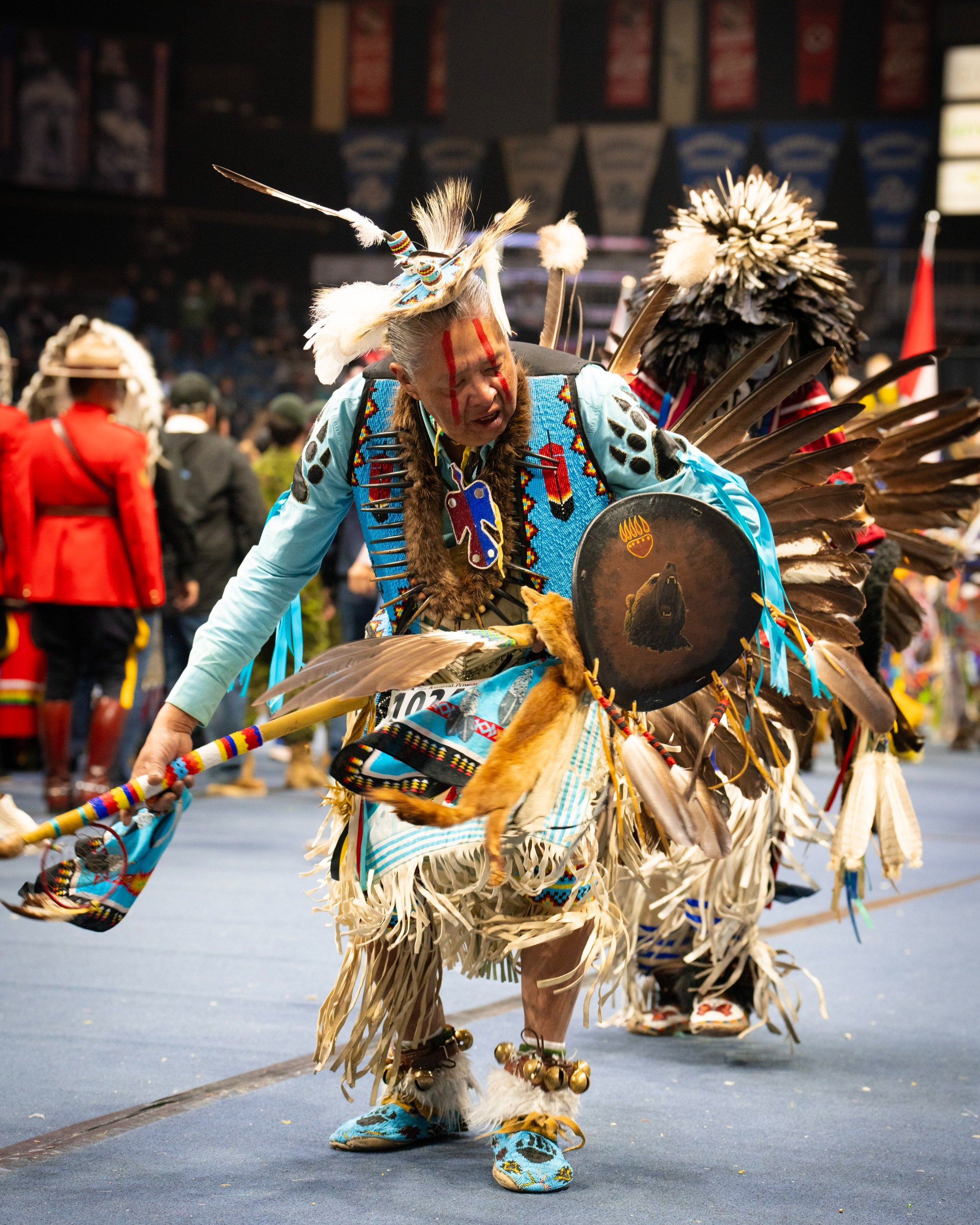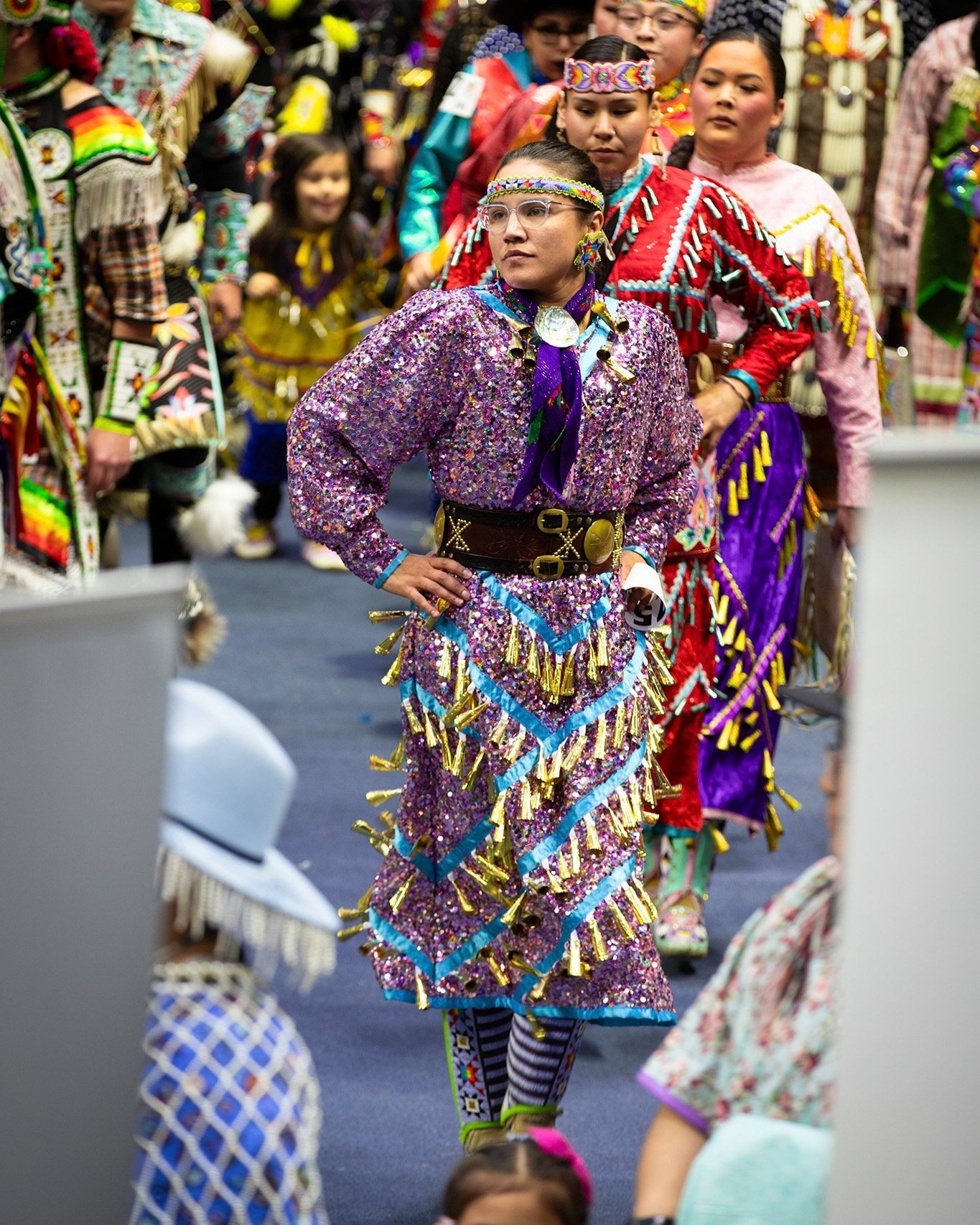Know Before You Go
Welcome to the Powwow!
A powwow has a few interpretations among the various tribes in Canada and the United States. It can be viewed as a celebration or a ceremony as there are historical and traditional aspects that people still follow today.
Powwow is a way to celebrate a way of life, through the numerous dance styles, hearing the different songs and drums, engaging with Elders, meeting new friends and extended family, and acknowledging the lands of the region. Everyone is welcome to attend, spectate, join in on the inter-tribals and make new connections.
Without the drum and songs, we could not have a powwow. The songs, some of which are passed down generationally, are the core of the “Big Drum” that is said to be parallel to the heartbeat of Mother Earth. Each drum group that participates in a powwow will have a “lead” or a “main” singer with other male singers, and at times, women back-up singers.
HEAD STAFF
OUR 2024 HEAD STAFF (Left to Right): Head Drum Judge: Alphonse Obey, SK, Head Dance Judge (Men’s Categories): Nelson Baker, ND, Arena Director: Teddy Bison, SK, Arena Director: Donovan Abbey, ND, Master of Ceremonies: Jeff Cappo, SK, Head Dance Judge (Women’s Categories): Kaleigh Starblanket, SK, Arena Director: Navarone Thunderchild, SK (not imaged: Master of Ceremonies: Tommy Christian, MT, Master of Ceremonies: Hal Eagletail, Sound: Wasteste Sound, Tabulation: C & T Tabulating)
In order to run the powwow smoothly, a Head Staff is selected which includes a Master of Ceremonies, at times this could be up to 2-3 individuals. Some regions acknowledge the MC’s in their language, such as ‘Eyapaha’ (Dakota). Other important roles are the Arena Director, Head Singing Judge and Head Dance Judge, all of whom work closely with the Powwow Committee.
A Host Drum or Drums are the main drum group that the committee or dancers may call upon to sing at appropriate times throughout the powwow. The singers can hail from different regions so it’s always nice to welcome different Tribes or Nations to the Territory. To keep up with the ever-changing way of powwow life, dance styles, and regalia have evolved over time as well.
Etiquette For Visitors
SHOW RESPECT TO EVERYONE YOU MEET AT THE EVENT
Respect is a fundamental value upheld by the First Nations University of Canada (FNUniv) and the FNUniv Spring Celebration Powwow Committee. Please be considerate towards everyone you encounter and during any part of the agenda that requires special acknowledgment.
HONOR THE SIGNIFICANCE OF CULTURAL PROTOCOLS
Many dancers wear sacred items as part of their regalia, such as eagle feathers or plumes. It's crucial that you do not touch any dancer's regalia without their permission. Additionally, a woman's monthly moon time (monthly cycle) is significant; if a woman is experiencing this, she should not be near or touch eagle feathers, eagle plumes, or approach a drum.
REQUEST PERMISSION BEFORE TAKING PHOTOS OF DANCERS OR THE EVENT
If this is your first powwow, you may wish to capture photos of the event or with a specific dancer. However, it is essential to ask for the dancer's permission before taking any photographs of them or with them.
STAND AND REMOVE HEADWEAR DURING SELECT SONGS
During the powwow, there will be designated songs when the Master of Ceremonies will invite you to stand and remove your hats. Please stay attentive to when this is requested. These songs will include Grand Entries, Flag Songs, Veteran Songs, Memorial Songs, Prayer Songs, and any other "Special" Songs.
We hope you have a wonderful experience at the powwow. If you have any questions, feel free to approach any of the Head Staff, Powwow Committee members, or a dancer or singer.
Grand Entry Time
The Grand Entry is the start of a powwow. The Arena Director and oskâpêwis will organize and coordinate the carriers of all Eagle Staffs and flags. Other Powwow Committee will assist with organizing all invited dignitaries, veterans, royalty and dancers.
Prior to each grand entry, the oskâpêwis will follow protocol and ask an Elder to say an invocation/prayer to bless the day. If there is a Host Drum, they will be asked to sing the Grand Entry song each time.
Throughout Grand Entry, it is asked for all spectators to stand and pay respect to the Eagle Staffs and Flags.
Grand Entry Order: (usually dance 4 to a row)
The eagle staffs/flags are danced in by a visiting Men’s dancer in front of the line. A specific Dance Style will be called up for each grand entry (Men’s Traditional, Men’s Grass, etc.). Each staff represents a Nation, organization, or family. Dignitaries will follow the eagle staffs/flags: dignitaries-chiefs, sponsors, committee, honourees', and visiting royalty (i.e., visiting princess’ and braves who represent their communities, festivals or pow wows.)
Dance Order:
Men’s traditional dancers, prairie chicken dancers, grass dancers, and fancy bustle dancers. Women’s traditional dancers, jingle dress dancers, and fancy shawl dancers followed by all Teens, and Junior categories, in the same order and lastly will be all tiny-tot dancers (no specific order).
The Arena Director will have asked the next drum in order to sing a flag song. Finally, the last song will be the victory/veteran dance. All dancers will dance in place to honour all veterans from all nations who fought in any war.
To conclude a Grand Entry, the Master of Ceremonies will introduce all Eagle staff carriers, Flag barriers, Dignitaries, Veterans, and Royalty individually. If any dignitaries have been asked to speak, they will do so after everyone is acknowledged. Following the conclusion of the grand entry, the first Intertribal will commence!
POWWOW DANCE STYLES
About the Men’s Grass Dance:
The Grass Dance style is a very old dance rich in history that has become very popular. In the old days, it was the job of the grass dancers to flatten the grass in the arena before a pow wow. The name “grass” does not come from the stomping of grass, but it comes from the old habit of tying braids of sweet grass to the dancer’s belts, producing a swaying effect. Today, Grass Dancers resemble a multicolored swaying mass of yarn or fringe on the dance floor. The Grass Dance is a very fluid and bendable style, with the dancers trying to move their fringe in as many places as possible at once. The Grass Dance style was born in the north, but its popularity has spread south, and now this beautiful style is available to everyone.
About the Men’s Fancy Dance:
A stick adorned with vibrant feathers is used to secure the roach atop the dancer's head, while a string wraps around the neck to attach the roach midway down the back. Two bustles are worn: one is fastened to the back with buckskin straps tied to the chin and chest, while the other is positioned at the waist. The dancers don intricately beaded capes and aprons, complemented by matching belts featuring side drops, cuffs, and moccasins. Small bustles matching the larger ones are worn on their arms. In hand, they carry sticks embellished with colorful feathers and ribbons. The entire ensemble is enhanced with multi-colored ribbons that add dynamism to their dance moves. Additionally, bells are worn on their calves, and white angora fur adorns their ankles. Horsehair may also be incorporated at the tips of the bustles.
About the Men’s Traditional Dance:
The movement in this style is one that is sometimes characterized as similar to a prairie chicken. The dancer is also said to be re-enacting the movement of a warrior searching for the enemy. In his hands, the dancer can carry a range of objects, commonly being a wing fan, pipe bag, dance stick, etc. The feather bustle is usually the u-shaped type with a single row of wing or tail feathers and two spikes pointing upward. Sometimes additional rows of dyed and stripped feathers, fluffs or hackles are on the inside rwo of the bustle. Most dancers wear a shirt, either with or without ribbon decoration. Over the shirt is worn a breastplate that usually extends below the waist. Around the neck is a choker either of hair pipes and beads or a beaded strip. It must be stressed that this is only a brief description as variations do exist from area to area and from tribe to tribe.
About the Men’s Chicken Dance:
The Men’s Prairie Chicken Dance originated from the Blackfeet and Cree of the Northern Plains, this dance is done as an imitation of the mating dance of prairie chicken grouse. Dance steps and movement of the dancer’s head and arms replicate the prairie chicken rooster as it fluffs up its feathers and struts about.
About the Women's Jingle Dress Dance:
The Jingle Dress Dance originated among the Ojibwe people long ago. Nowadays, whenever someone needs healing of their physical, mental, or emotional self, the Jingle Dancers are called upon. Many healings have taken place; therefore, the dance is a respected and revered one. Though frequently utilized for healing ceremonies, the Jingle Dress is also done in competitions nationwide. The regalia is a very colorful and bright one, decorated with beadwork, ribbons, paint, or appliqués and worn with matching barrettes, purse, leggings, and moccasins. The dress itself gleams with row after row of jingles numbering into the several hundreds. The jingles are typically made of the lids from snuff cans. The lids are rolled into bell shapes and sewn very closely together onto the dress by ribbons. As each cone is attached, a different prayer is spoken. The closeness of the jingles results in the lovely tinkling sound that is produced when the dancer is right in time with the drum.
About the Women's Traditional Dance:
Each tribe has specific dress and dance styles, the following are the more typical ones seen at a powwow. The northern Plains traditional dancers are sometimes referred to as “stationary” dancers. They stand on the outer edge of the dance arena. They barely move their feet and gently bend their knees and sedately move up and down in rhythm with the drum. The northwestern tribes dance around the arena moving their feet and heads in rhythm with the drum. The cloth dress and buckskin dresses are different but the dance style is the same for most of the northern Plains tribes. The northern traditional buckskin dresses are elaborately decorated with beadwork. The yoke and sleeves of the dresses are completely beaded. The dress may also be decorated with porcupine quillwork, shells, elk teeth, or brass beads. The remainder of the outfit includes matching headbands or crown, hair ties, purse, moccasins, chokers, earrings and shawl. Women who have an Indian name will wear an eagle feather or eagle plume in their hair.
About the Women's Fancy Dance:
The women’s fancy dance features a fast pace and the distinctive brightly colored shawl. The shawl itself is an adaptation of the blanket carried or worn traditionally by women. That and other similar actions led women to develop a Fancy Dance for females. The regalia is simple: a basic dress, a yoke, moccasins, leggings and a shawl worn over the shoulders and arms. Fancy shawl dancers typically wear plumes and side drops in their hair. As the years progressed, contemporary Fancy Shawl outfits have become brighter, fancier and more intricately detailed. Original style fancy shawl outfits are not as brightly coloured and detailed. The original style dance has more footwork but not as much twirls and kicks.










